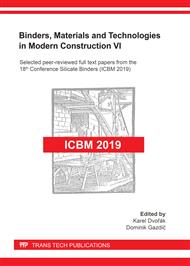p.3
p.9
p.15
p.23
p.29
p.37
p.45
p.51
Influence of Cement Type on Stability of Concrete Mixture
Abstract:
The continuous tightening of emission limits for the production of harmful substances into the air and the rising price of emission allowances gradually force construction material producers to limit the use of binders with a high content of Portland clinker. In the production of concrete, this is achieved by using admixtures, which make it possible to reduce Portland cement doses. However, the single European market uses a method that maximises the use of blened cements, making it easier for cement plants to meet emission limits while not reducing cement production. The performed experiment focused on the possibility of using CEM II and CEM III cements and their comparison with CEM I cement not only in terms of the physical–mechanical parameters of concrete but also in terms of the stability of concrete mixtures made from these cements. The stability of concrete mixtures was monitored using the water separation value in the pressure method. In the experiment, the relationship between water separation and physical parameters of cement was explored.
Info:
Periodical:
Pages:
15-21
Citation:
Online since:
July 2021
Authors:
Keywords:
Price:
Сopyright:
© 2021 Trans Tech Publications Ltd. All Rights Reserved
Share:
Citation:


